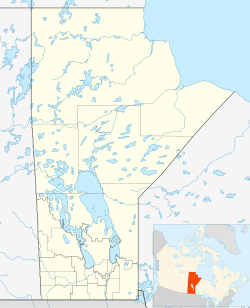Baldur | |
|---|---|
 The grain elevator and Veteran Park in Baldur. | |
| Coordinates: 49°23′08″N99°14′37″W / 49.38556°N 99.24361°W | |
| Country | Canada |
| Province | Manitoba |
| Area | |
• Total | 2.21 km2 (0.85 sq mi) |
| Population (2016) [1] | |
• Total | 320 |
| • Density | 144.9/km2 (375/sq mi) |
| Time zone | UTC−5 (CST) |
| • Summer (DST) | UTC−6 (CDT) |
Baldur is an unincorporated community recognized as a local urban district in the Rural Municipality of Argyle, Manitoba. [2]
Contents
Baldur is the largest community of the Argyle municipality, which is in southwestern Manitoba between Brandon and Portage la Prairie. The community is named after the Norse god Baldur, reflecting the Icelandic heritage of the people in the community. [3]

